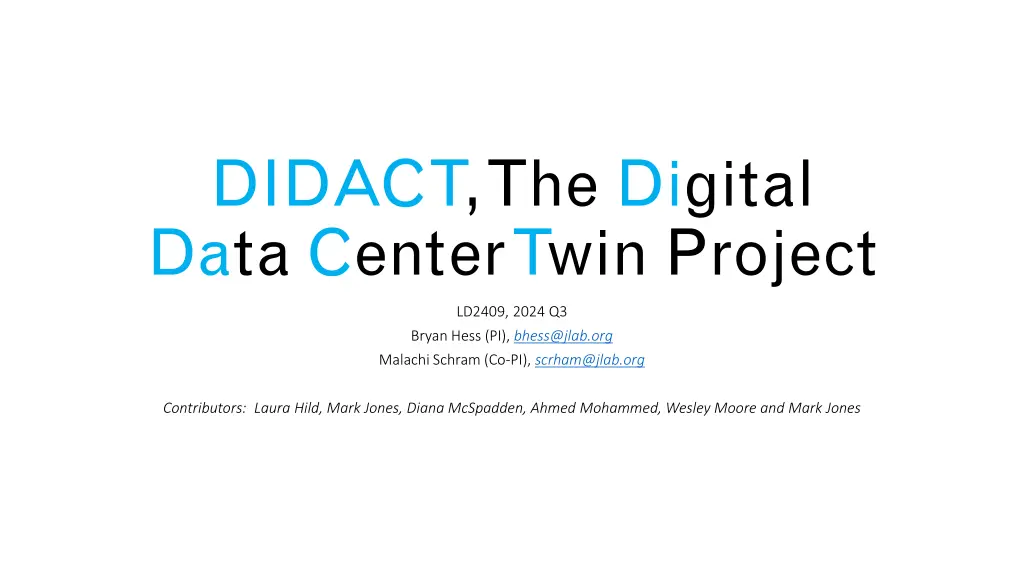
MLOps Capability for Continual Learning in Compute Cluster
"Discover how the DIDACT project is establishing an MLOps capability for continual learning in compute clusters, enabling real-time diagnostics and operational insight. Save time with GPU-based batch processing and champion model training. Learn more about the CL pipeline and the MLOps stack. Explore the latest updates and future developments in this exciting digital data center project."
Download Presentation

Please find below an Image/Link to download the presentation.
The content on the website is provided AS IS for your information and personal use only. It may not be sold, licensed, or shared on other websites without obtaining consent from the author. If you encounter any issues during the download, it is possible that the publisher has removed the file from their server.
You are allowed to download the files provided on this website for personal or commercial use, subject to the condition that they are used lawfully. All files are the property of their respective owners.
The content on the website is provided AS IS for your information and personal use only. It may not be sold, licensed, or shared on other websites without obtaining consent from the author.
E N D
Presentation Transcript
DIDACT, The Digital Data Center Twin Project LD2409, 2024 Q3 Bryan Hess (PI), bhess@jlab.org Malachi Schram (Co-PI), scrham@jlab.org Contributors: Laura Hild, Mark Jones, Diana McSpadden, Ahmed Mohammed, Wesley Moore and Mark Jones
DIDACT 2024 Q3 Status Digital Data Center Twin Project Publications, Conferences, Proposals Establishing MLOps for Continual Learning in Compute Clusters Accepted for upcoming issue of IEEE Software Item Description Progress Notes Summary and detail dashboards in Grafana Completed, also includes MLFlow dashboards H1M1 Decode the Workload: Training Deep Learning Models for Efficient Compute Cluster Representation Accepted as poster for CHEP 2024 Continuous learning process with daily updates Completed H1M2 This MLOps capability Included in the current AI FOA Human in the loop to vet out-of-distribution events Deferred/Linked to H2M2. Integral to the MLOps contunual learning framework H1M3 Study the performance of Variational AutoEncoder and Graph Neural Network (GNN) models AE performs better than VAE. GNN did not add signifcant value for these cases. BERT under study. Sampling rate issue. H1M4 Measure and characterize key timing characteristics to understand continuous learning cadence Examples: Compared entire data set on GPU vs batch; offline data prep procedure; data storage H1M5 Cluster Model: Use embeddings on each node to feedback to continuous learning model to develop a cluster level model To be studied H2M1 Develop workflow to version, evaluate, and roll back models when needed Tied to H1M3 and MLOps workflow above. H2M2 Operationalize; make more robust; test with system administrators to gauge user experience and utility Error handling in MLOps framework started; Integration with GitLab and CI/CD process TBD. H3 M3 Alternate scheduler and/or node level automatic controls Node-level controls developed. Scheduling Mechanism to be studied H4 M4
More Detail: DIDACT MLOps We are building an MLOps (Machine Learning + DevOps) capability focused on the continual learning (CL) of a compute cluster Why? The CL pipeline saves model, metadata, and metrics to MLFlow MLFlow maintains a versioned model archive, supports reproducibility Near real-time diagnostics of the compute cluster can provide operational insight into the state of the system MLOps stack: MLFlow -> Prometheus -> Grafana How? 3 Nightly Jobs: 1. Save yesterday s raw data from testbed nodes and farm 2. Pre-process (AI-ready) yesterday s data and save 3. Load the current champion model and train on pre- processed data. After training, the new champion model is registered and can be loaded for real-time inference. New GPU-based Batch-Iterator loads all data onto GPU. Significantly decreased training time. (40% of training time with CPU features)
More Detail: Data & AutoEncoder (AE) model Jobs: IO Jobs: 2 flavors (Good-Bin, Bad-Bin) MPI jobs: 2 flavors (MPI-2, MPI-16) Clara-Runtime: 4 flavors (1, 2, 4, 8) Pypwa: 3 flavors (jpac, mcmc, minuit) Idle: Idle CPUs are considered as a distict "job" AutoEncoder (AE) Model: Unconditional AE (HW info is NOT used) with almost 40K trainable parameters / T = 1 / z_size = 2 Encoder: Considers only timestep of the variables [ idle , iowait , system , user , other ] ==> Compresses into z of size 2. Decoder: Reconstructs the variables back from the compressed z Top right figure shows the ability of AE to preserve the clustering performed by Principal Component Analysis (PCA). For example, consider good-binned-io: AE keeps all the x points intact as they appear on PCA. Bottom figures show the ability of the AE in capturing the salient features of the input. Talk Title Here 5
Looking Ahead: Incorporating Data Center Power Modeling What? Server Power as aspect of node Modeling Data Sources include Networked power distribution units System baseboard (e.g. Redfish) Kernel-level power statistics Why? Modeling Systems to include power may illuminate efficiencies in power consumption e.g. wall time vs power use Power optimization data-center wide Load shedding during peak periods Current Exploration Instrumenting Job Execution with power monitoring to test viability of the approach Testing kernel-level controls to alter power consumption Talk Title Here 6
